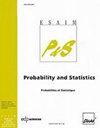Numerical schemes for a moving-boundary convection-diffusion-reaction model of sequencing batch reactors
IF 0.6
4区 数学
Q4 STATISTICS & PROBABILITY
引用次数: 0
Abstract
Sequencing batch reactors (SBRs) are devices widely used in wastewater treatment, chemical engineering, and other areas. They allow for the sedimentation and compression of solid particles of biomass simultaneously with biochemical reactions with nutrients dissolved in the liquid. The kinetics of these reactions may be given by one of the established activated sludge models (ASMx). An SBR is operated in various stages and is equipped with a movable extraction and fill device and a discharge opening. A one-dimensional model of this unit can be formulated as a moving-boundary problem for a degenerating system of convection-diffusion-reaction equations whose unknowns are the concentrations of the components forming the solid and liquid phases, respectively. This model is transformed to a fixed computational domain and is discretized by an explicit monotone scheme along with an alternative semi-implicit variant. The semi-implicit variant is based on solving, during each time step, a system of nonlinear equations for the total solids concentration followed by the solution of linear systems for the solid component percentages and liquid component concentrations. It is demonstrated that the semi-implicit scheme is well posed and that both variants produce approximations that satisfy an invariant region principle: solids concentrations are nonnegative and less or equal to a set maximal one, percentages are nonnegative and sum up to one, and substrate concentrations are nonnegative. These properties are achieved under a Courant-Friedrichs-Lewy (CFL) condition that is less restrictive for the semi-implicit than for the explicit variant. Numerical examples with realistic parameters illustrate that as a consequence, the semi-implicit variant is more efficient than the explicit one.序批式反应器移动边界对流扩散反应模型的数值格式
序批式反应器(sbr)是广泛应用于污水处理、化工等领域的设备。它们允许生物质固体颗粒的沉降和压缩,同时与溶解在液体中的营养物质发生生化反应。这些反应的动力学可以由一种已建立的活性污泥模型(ASMx)给出。SBR在不同的阶段运行,并配有可移动的提取和填充装置和出料口。该单元的一维模型可以表述为对流-扩散-反应方程组退化系统的移动边界问题,其未知数分别是形成固相和液相的组分的浓度。该模型被转换为一个固定的计算域,并通过显式单调格式和备选半隐式变量进行离散化。半隐式变体是基于在每个时间步骤中求解总固体浓度的非线性方程系统,然后求解固体成分百分比和液体成分浓度的线性系统。证明了半隐式格式是良好的,并且两种变体产生的近似满足不变区域原理:固体浓度是非负的,小于或等于一组最大值,百分比是非负的,总和为1,底物浓度是非负的。这些性质是在Courant-Friedrichs-Lewy (CFL)条件下实现的,该条件对半隐式变量的限制比显式变量少。具有实际参数的数值算例表明,半隐式变型比显式变型更有效。
本文章由计算机程序翻译,如有差异,请以英文原文为准。
求助全文
约1分钟内获得全文
求助全文
来源期刊

Esaim-Probability and Statistics
STATISTICS & PROBABILITY-
CiteScore
1.00
自引率
0.00%
发文量
14
审稿时长
>12 weeks
期刊介绍:
The journal publishes original research and survey papers in the area of Probability and Statistics. It covers theoretical and practical aspects, in any field of these domains.
Of particular interest are methodological developments with application in other scientific areas, for example Biology and Genetics, Information Theory, Finance, Bioinformatics, Random structures and Random graphs, Econometrics, Physics.
Long papers are very welcome.
Indeed, we intend to develop the journal in the direction of applications and to open it to various fields where random mathematical modelling is important. In particular we will call (survey) papers in these areas, in order to make the random community aware of important problems of both theoretical and practical interest. We all know that many recent fascinating developments in Probability and Statistics are coming from "the outside" and we think that ESAIM: P&S should be a good entry point for such exchanges. Of course this does not mean that the journal will be only devoted to practical aspects.
 求助内容:
求助内容: 应助结果提醒方式:
应助结果提醒方式:


